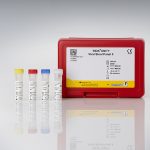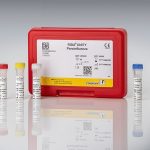Intended use:
For in vitro diagnostic use. The RIDA®UNITY RSV & hMPV test, performed on the RIDA®UNITY Platform, is a multiplex real-time RT-PCR for the direct qualitative detection and differentiation of respiratory syncytial virus (A/B) and human metapneumovirus (A/B) RNA in untreated human nasal/throat swabs and BAL from persons with signs and symptoms of acute respiratory infection.
The RIDA®UNITY RSV & hMPV test is intended to support the diagnosis of viral (RSV & hMPV) infections in patients with symptoms of respiratory infection in connection with other clinical and laboratory findings.
Negative results do not rule out infection with RSV or hMPV and should not be used as the sole basis for diagnosis.
The product is intended for professional use.
General information:
The human respiratory syncytial virus (RSV) is considered one of the most potent pathogens for acute infections of the lower respiratory tract such as lung inflammation and bronchiolitis. A high incidence of RSV infections has been found especially in children less than 6 months old. RSV is associated with elevated morbidity and mortality in not just children but also the elderly, patients with prior illnesses, and immunocompromised adults. RSV is a nonsegmented, enveloped RNA virus that belongs to the Pneumoviridae family. The viral genome, a single-stranded RNA (ssRNA) molecule, codes for 11 proteins. Given the antigenicity of its G protein, the strain is divided into two antigen groups: RSV A and B. Currently, 14 genotypes of RSV A and 25 genotypes of RSV B are known. Several studies have come unanimously to the conclusion that RSV is the most commonly detected respiratory virus. In particular, RSV outbreaks occur during winter from November to March. The height of infections is mainly in January. RSV generally manifests together with other respiratory viruses.
The human metapneumovirus is an enveloped virus-like particle that belongs to the Pneumoviridae family like RSV. The viral genome is single-stranded RNA (ssRNA), which consists of 8 genes. The hMPV strain was divided into two different genotypes, A and B. Each group is also further divided into two subgenotypes 1 and 2 (A1, A2, B1, B2) that are based on the genetic differences in the surface proteins F and G. Both genotypes can coexist and circulate simultaneously during the same period, whereas group A is generally the dominant genotype. However, the distribution depends on the seasonality and region. Infections with hMPV can occur throughout the year, but infection usually peaks at the end of the winter season. Clear seasonality is evident, especially with high infection rates in January.(9,11) Coinfections with other pathogens of the respiratory tract, such as the respiratory syncytial virus (RSV), have been described several times.
According to studies, RSV and hMPV, in addition to influenza, are the predominant viral pathogens during the winter season and, therefore, show consistent seasonality(12). The most common symptoms of acute respiratory tract infections are fever, cough, sore throat, headaches, tachypnea, rales, stridor, wheezing, or symptoms of the upper respiratory tract (rhinorrhea and sneezing), and fatigue.
Accessories:
| Art. No. | UN5905 |
|---|---|
| Test format | real-time PCR with 96 reactions |
| Shelf life | 12 month after production |
Dear customers,
we have started to provide the documents for our products in an electronic format. These are the Instructions for Use (IFU), the Safety Data Sheets (SDS) and the Certificate of Analysis (CoA). For batches placed on the market after 01 January 2023, you can find our documents on the eIFU portal eifu.r-biopharm.com.










